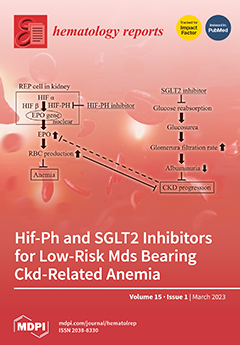Open AccessEditor’s ChoiceCase Report
Mutational Profile and Pathological Features of a Case of Interleukin-10 and RGS1-Positive Spindle Cell Variant Diffuse Large B-Cell Lymphoma
by
Joaquim Carreras, Yara Yukie Kikuti, Masashi Miyaoka, Shinichiro Hiraiwa, Sakura Tomita, Haruka Ikoma, Yusuke Kondo, Atsushi Ito, Shunsuke Nagase, Hisanobu Miura, Giovanna Roncador, Lluis Colomo, Rifat Hamoudi, Elias Campo and Naoya Nakamura
Cited by 4 | Viewed by 4184
Abstract
Diffuse large B-cell lymphoma with spindle cell morphology is a rare variant. We present the case of a 74-year-old male who initially presented with a right supraclavicular (lymph) node enlargement. Histological analysis showed a proliferation of spindle-shaped cells with narrow cytoplasms. An immunohistochemical
[...] Read more.
Diffuse large B-cell lymphoma with spindle cell morphology is a rare variant. We present the case of a 74-year-old male who initially presented with a right supraclavicular (lymph) node enlargement. Histological analysis showed a proliferation of spindle-shaped cells with narrow cytoplasms. An immunohistochemical panel was used to exclude other tumors, such as melanoma, carcinoma, and sarcoma. The lymphoma was characterized by a cell-of-origin subtype of germinal center B-cell-like (GCB) based on Hans’ classifier (CD10-negative, BCL6-positive, and MUM1-negative); EBER negativity, and the absence of
BCL2,
BCL6, and
MYC rearrangements. Mutational profiling using a custom panel of 168 genes associated with aggressive B-cell lymphomas confirmed mutations in
ACTB,
ARID1B,
DUSP2,
DTX1,
HLA-B,
PTEN, and
TNFRSF14. Based on the LymphGen 1.0 classification tool, this case had an ST2 subtype prediction. The immune microenvironment was characterized by moderate infiltration of M2-like tumor-associated macrophages (TMAs) with positivity of CD163, CSF1R, CD85A (LILRB3), and PD-L1; moderate PD-1 positive T cells, and low FOXP3 regulatory T lymphocytes (Tregs). Immunohistochemical expression of PTX3 and TNFRSF14 was absent. Interestingly, the lymphoma cells were positive for HLA-DP-DR, IL-10, and RGS1, which are markers associated with poor prognosis in DLBCL. The patient was treated with R-CHOP therapy, and achieved a metabolically complete response.
Full article
►▼
Show Figures






